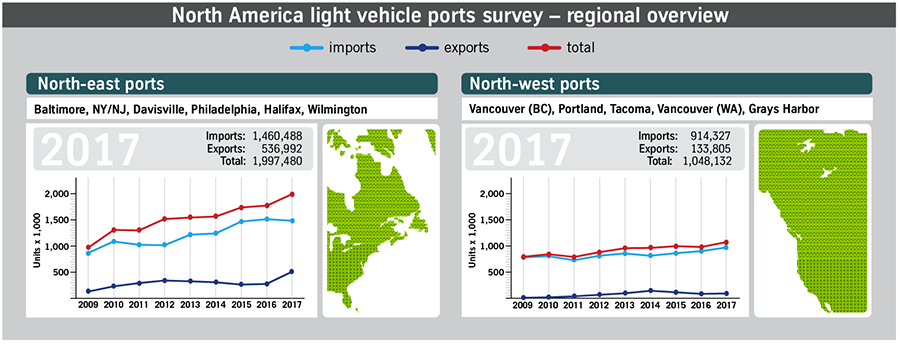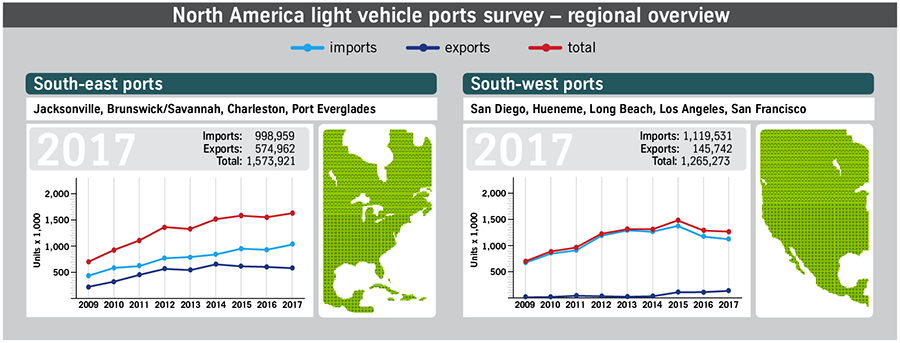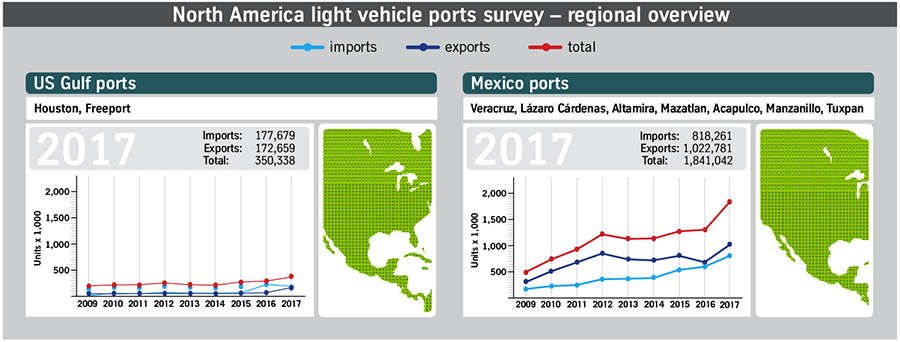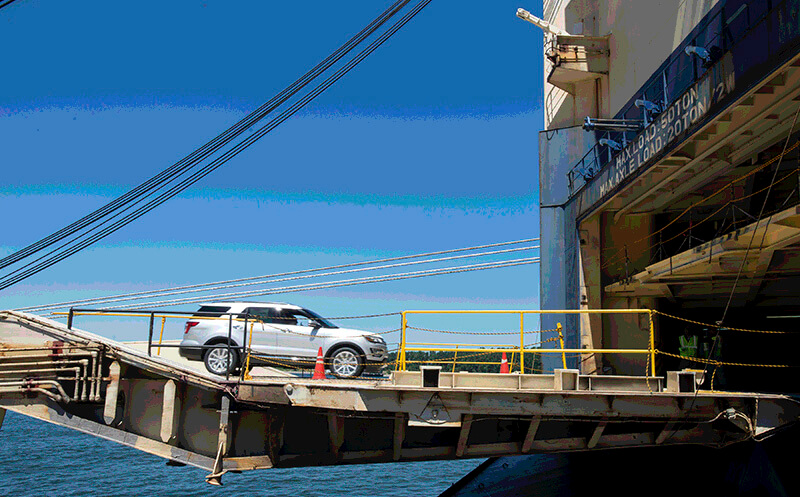 Mexican production and exports continued to grow through 2017, both to the US and globally. At the same time, US sales remained strong and were fed by an increase in imports from established and emerging markets. It is only in Canada that both sales and assembly are showing a decline.
Mexican production and exports continued to grow through 2017, both to the US and globally. At the same time, US sales remained strong and were fed by an increase in imports from established and emerging markets. It is only in Canada that both sales and assembly are showing a decline.
For the majority of North American ports, last year was one marked by increased throughput, which brought demands on infrastructure and connectivity, and a continued need for investment in land and equipment to ease congestion. One thing that has helped is that Hyundai/Kia has modified its terms of sale to its dealers in North America and has been able to reduce inventory levels at all of its ports of entry by 50%. It is in Mexico, particularly at Veracruz, that congestion continues to plague carmakers and logistics providers.
Mexico made 3.8m vehicles last year, an increase of almost 9% compared with 2016, and the forecast for 2020 is for 5m units. The SUV and premium segments are on the increase, and the majority of its output is exported: of total production, 3.1m vehicles were exported last year, up 12% on 2016. Meanwhile, domestic sales are climbing to the 2m mark towards 2020.
In the US, vehicle sales hit 17.2m last year, and while they are forecast to stand still over the next four to five years, they will do so at a strong level – around the 16.5m mark. According to analyst PwC Autofacts, US vehicle imports increased again in 2017, reaching nearly 8.3m units, up 1.4% on the year and 19% since 2012. Mexico sent 2.4m vehicles to the US, an increase of 12.3% and a development that has been registered at ports around the US whether on the east, west or Gulf coasts.
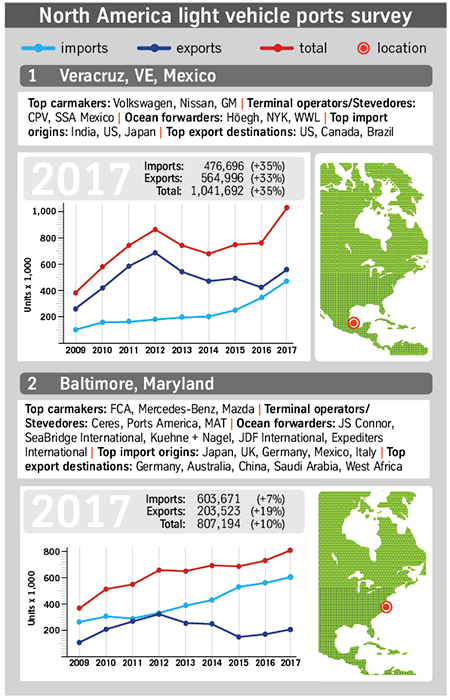 Canada exported 1.8m vehicles to the US last year, an increase of 8.1%, despite its light vehicle assembly dropping by 400,000 units to 2m with no sign of a recovery through to 2024. Japan was the next biggest point of origin for vehicles coming through US ports, contributing 1.7m, a more marginal increase of 1% year-on-year.
Canada exported 1.8m vehicles to the US last year, an increase of 8.1%, despite its light vehicle assembly dropping by 400,000 units to 2m with no sign of a recovery through to 2024. Japan was the next biggest point of origin for vehicles coming through US ports, contributing 1.7m, a more marginal increase of 1% year-on-year.
Threats and promises
What also happened in 2017, however, was the inauguration of Donald Trump and, since January last year, the new administration in Washington has made a number of trade policy decisions that could have a direct impact on North American ports. This includes the renegotiation of Nafta – which has already had an impact on production and logistics – and the imposition of tariffs on China that have sparked off a trade war. Following threats of tariffs to carmakers importing to the US from Mexico, the Trump administration imposed tariffs on steel and aluminium imports, and has threatened 25% tariffs on billions of dollars’ worth of Chinese imports. China has retaliated by saying it will impose a 40% levy on vehicles made in the US, up from the current tariff rate of 15%.
How prolonged trade disputes within and beyond North America could affect the ports sector is uncertain, though tariffs on vehicles now being applied by the US and China, and the threat of a 20% tariff being imposed on cars imported from Europe, are bound to affect the type of vehicles being imported and exported.
Ports and vehicle terminal operators have been cautious in their response to trade policy developments over the last year.
“We’ve seen trade disputes before and, eventually, these disagreements have been worked out, and the global economy continues to grow and prosper,” says an optimistic Mario Cordero, executive director of the port of Long Beach on the US west coast. “Our role is to facilitate trade, and the port is closely monitoring proposals by Washington and Beijing to levy higher tariffs on one another’s products. The same goes for Nafta negotiations.”
The Port of Los Angeles authority is watching the situation closely in the hope that a trade war with China can be averted – not surprising given how much trade goes through the port.
“Obviously a trade war with China has the potential to have a significant impact on the port of Los Angeles,” says the spokesperson. “China is by far the Port of Los Angeles’ largest trading partner. In 2017, $284 billion worth of goods passed through the port of LA. Of that, $145 billion in trade – more than half – was with China and Hong Kong.”
Down the coast at San Diego port, it is a case of wait and see, because of the unclear plan of implementation being pursued by the current US administration. On the question of Nafta, however, a spokesman for the port admitted that if tariffs were imposed on vehicle importers, there could be a negative impact.
“However, if there are quotas set on the amount of land-based auto commodities, like we have seen for other types of commodities, then that may push OEMs towards seeking waterborne transport, which may increase coastal shipping opportunities for our port,” he says.
The west coast port of Portland, by contrast, has seen exports grow over the past couple of years, with the main volumes going to China and Korea.
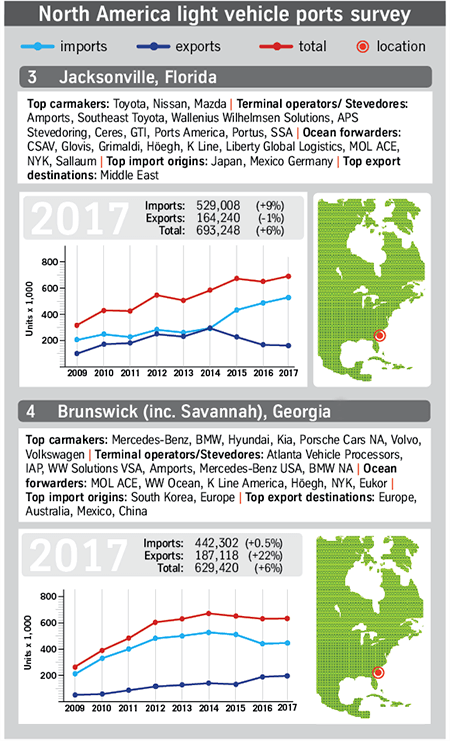 “We strongly believe that an open trade relationship with foreign countries delivers better jobs and a higher standard of living for Pacific Northwest workers,” she says. “We’ve seen growth in auto exports to China and we hope that trend will continue.”
“We strongly believe that an open trade relationship with foreign countries delivers better jobs and a higher standard of living for Pacific Northwest workers,” she says. “We’ve seen growth in auto exports to China and we hope that trend will continue.”
On the east coast, meanwhile, vehicle trade with China is not so significant for the Port of New York and New Jersey authority (PANYNJ) due to the relatively small number of vehicles it imports from there, so the main concern is uncertainty over the Nafta negotiations.
“Recent tariffs have resulted in all sides taking a very defensive position,” admits a spokesperson for the port authority. “In terms of the auto industry and its projected positive growth, that hinges on successful renegotiation.”
Finding room for manoeuvre in Mexico
Mexico remains confident in the face of uncertainty as negotiations with the US over Nafta continue. Each of its vehicle handling ports has shown an increase in vehicle handling, and there have been a number of new investments to expand facilities and infrastructure.
Veracruz, North America’s busiest car-handling port, processed 58% of total volumes through the Mexican ports in 2017 but the growth there continues to be hindered by congestion; lagging infrastructure is causing headaches for carmakers and logistics providers.
Roberto Zavala, head of Mexico for VSM Logistics, part of Wallenius Wilhelmsen Solutions (WW Solutions), says that congestion is a major concern: “More than a million vehicles were handled at the port in 2017, an increase of 34% on 2016, basically through the same infrastructure.”
Added to that is the fact that vehicle sales in the US have slowed and, according to Zavala’s colleague Flavio Batista, head of North American sales at Wallenius Wilhelmsen Ocean (WW Ocean), that slowdown is causing capacity issues.
The simple fact is that space is limited and there are not enough berths, says Bill Kerrigan, vice-president of logistics at SSA Marine Auto, meaning vessels bringing vehicles into Mexico are often left sitting in the ocean for days until exports have been moved.
Veracruz infrastructure
The Veracruz port authority is working on infrastructure improvements to support that growth to over 1m units. The work currently underway includes a completely new landside and berth development – Zona de Actividades Logísticas (ZAL) – to the north of the port’s existing facilities. Phase one of the first stage of that development is due for completion in 2019. A vehicle terminal at the new location is planned for the second stage, which will be completed by 2024.
The port authority is also relocating space in the existing port for vehicle handling, and building new rail links that will allow rail providers Ferromex and KCS de Mexico to compete on a level basis for terminal-side access to the port (KCS currently has to pay Ferromex for rights of access on the one existing line). The port has indicated that 19.5km of double track will be open by the first quarter of 2019.
However, for the moment, road transport accounts for 76% of vehicle moves in and out of the port, which is a 10% increase on 2016 and has meant that the price for trucking services has gone up. Added to that is the fact that bi-level rail car supply suffered towards the end of 2017. Roberto Zavala says the lack of empty, available bi-level rail cars was an issue.
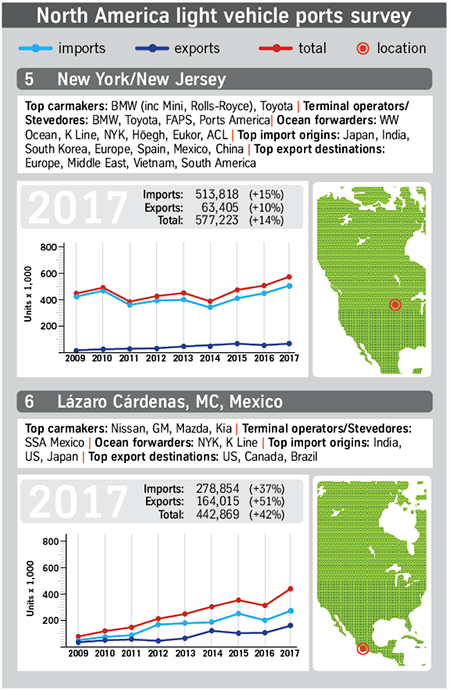 Yet at the same time, WW Ocean has also benefitted from rail car shortages, according to Wayne Washington, vice-president and head of business development, Americas and EUMEA, who says that rail car challenges out of Mexico have created opportunities to support spot ocean services to the US, primarily on the east coast.
Yet at the same time, WW Ocean has also benefitted from rail car shortages, according to Wayne Washington, vice-president and head of business development, Americas and EUMEA, who says that rail car challenges out of Mexico have created opportunities to support spot ocean services to the US, primarily on the east coast.
Off-port storageOn the plus side, the port authority at Veracruz is now working with carmakers including VW, Nissan, Honda and Mazda on a brand quality project and the port is using an IT platform to improve efficiency through better management of space and the removal of paperwork. That platform has been developed with the customs agency at Veracruz, together with API (the port’s administration body).
At the same time, Höegh Autoliner’s daughter company, Horizon Terminal Services (HTS), through its Horizon Auto Logistics division, has set up two off-port storage and processing yards to help relieve pressure at Veracruz and the facilities are now being used by several OEMs for a range of services including stevedoring, shuttle services, off-port yard storage and pre-delivery inspection (PDI).
Per Folkesson, president of HTS, says that the port should not be used as a parking garage, and that suppliers and OEMs need to support that principle and do what is required to avoid using it as such.
“In Veracruz, in particular, there would be no port yard congestion issues nor vessel delays (other than for weather and wind) if we all came together and worked accordingly,” says Folkesson.
Tomasz Lis, head of sales for Mexico and the Caribbean at Höegh Autoliners, agrees, saying that as congestion is a problem for all the OEMs using the port, more should be looking to use off-port yards first and shuttle volumes in for loading onto vessels. That, he says, would increase the dynamic capacity at the port and its overall performance.
Horizon Auto Logistics opened an off-site processing and storage facility at Puente Villa Rica, 15km from Veracruz port, earlier this year.
“Our port operations in Veracruz, combined with truck shuttle, our Puente Villa Rica inland yard and Mexico distribution services, have proven to provide the efficiencies needed in the automotive supply chain,” says Folkesson. “In fact, we have so far reduced the dwell time in the port per vehicle by more than half, from over ten days per car to less than five days per car.”
Horizon Auto Logistics can control the truck flow from its facility to the port to ensure minimum storage times at the port and operates on a 24/7 basis inside the port, which no other provider does, says Folkesson.
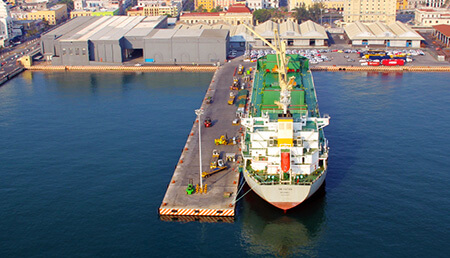
OEMs using the port of Veracruz
According to Kerrigan, off-site yards are useful for staging exports but there still needs to be space available to bring them in for loading; that is in short supply at Veracruz.
Demand at Lázaro CárdenasWhile Veracruz works on upgrades to deal with the increase in trade, there have been a number of developments at the other ports in Mexico.
Lázaro Cárdenas handled an additional 131,000 vehicles in 2017 compared with the previous year, with the total for the year hitting around 442,900.
SSA Marine, through its division SSA México, has been working on the development of its Special Automobile Terminal at the port through 2017 and completed the first phase in April this year. The rail-connected facility currently has storage for 17,300 vehicles over 43.2 hectares and has the capacity to handle 72 bi-level or tri-level rail cars at one time.
Bill Kerrigan at SSA Marine Auto says that with the new facility up and running, the port should be able to process 450,000, up on the 386,000 it handled last year. Of that 2017 total, SSA Marine handled almost 245,000 (Amports is also handling volumes through the port).
Höegh Autoliners is calling at Lázaro Cárdenas and exported more than 4,400 vehicles from the port in 2017. The company has added a connection from the port to Australia and New Zealand via the US east coast and the Pacific side of Mexico, according to Tomasz Lis.
WW Ocean has also started calling at the port to run services to Australia and New Zealand, as well as setting up a short-sea service out of the port of Altamira to the US. According to Batista, the additional port calls in Mexico were triggered initially by new business with a carmaker, but WW Ocean is working hard to develop high and heavy business on both the new trade lanes.
Lázaro Cárdenas is also already benefitting from volumes coming out of Audi’s plant in San José Chiapa since it started production of the Q5 back in 2016 and the carmaker is now also trialling volumes out of Tuxpan on the east coast to avoid bottlenecks at Veracruz.
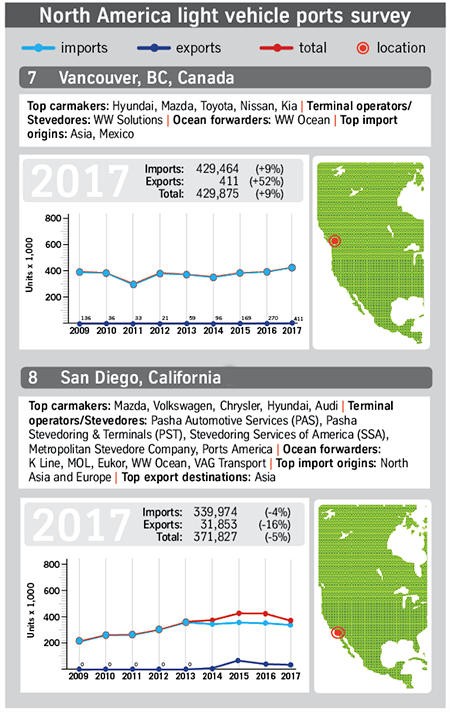 In fact, a number of carmakers are now looking at Tuxpan, which was originally a container handling port, for vehicle processing and it handled 26,970 units last year. Bill Kerrigan points out that vessel operators can get in and out of the port quickly and, while it means an extra call, they are not sitting in a queue for four days outside Veracruz.
In fact, a number of carmakers are now looking at Tuxpan, which was originally a container handling port, for vehicle processing and it handled 26,970 units last year. Bill Kerrigan points out that vessel operators can get in and out of the port quickly and, while it means an extra call, they are not sitting in a queue for four days outside Veracruz.
Safety at seaThe perennial vandalism that affects land-based vehicle movements in Mexico has had an effect on port throughput as carmakers have moved additional volumes to short-sea. To take one example, GM started shipping vehicles that were previously taken by rail into the US port of Grays Harbor by short-sea last year, and also to Aransas in Texas. The carmaker made the move to avoid vandalism on the rail routes north to the border, though the problem does not affect the west coast.
The effort made by the Mexican government to control theft and vandalism, which was rife in the Bajio region, has actually resulted in a migration of the problem to the area around Veracruz. While acknowledging this fact, rail provider KCS says it has made significant investments in the last few years in security, rail infrastructure and equipment to improve the situation; Kerrigan, for one, recognised what the company has achieved.
The move to short-sea because of vandalism, however, has been noted north of the border. Brian Mason, vice-president, business development and administration at Pasha Automotive Services, which provides services on the US west coast, said volumes out of Mexico had shifted to short-sea because of high levels of vandalism, though that subsided towards late 2017 and in the first half of this year. The company has seen increased inbound volumes on both rail and short-sea, and increases in inbound truck volume out of Mexico over the same period.
US east coast sees rise in foreign importsVehicle imports into the US, which increased 1.4% to reach 8.3m units last year, are driving volume increases at all of the ports on the east coast. Mexico continues to grow as a point of origin but there were new and growing volumes from India, Europe and even China, though the recent trade war between the US and China could stem that flow. Nevertheless, the increase in throughput is being met with investment in port infrastructure.
Once again, Baltimore remains the busiest US port for finished vehicle handling and the second busiest in North America overall. A 10.3% increase in volumes was helped by a good year for Honda in 2017 and a rise in used car exports to West Africa.
“Honda began importing cars from the UK to the port of Baltimore and exporting cars to Mexico,” says Larry Johnson, marketing and sales head at the Maryland Port Administration (MPA). Added to that, GM is importing units via Baltimore from Mexico and Ford has begun an import programme from India through the port.
Mexico is now one of its main import sources along with northern Europe and Japan, while exports from Baltimore mainly go to northern Europe, the Middle East, South America and the Oceanic markets of Australia and New Zealand.
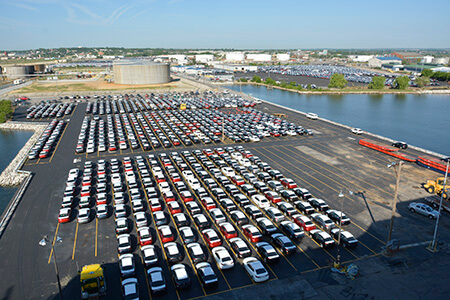 Baltimore is developing land at one of its terminals to handle greater throughput
Baltimore is developing land at one of its terminals to handle greater throughputBaltimore is managing the increased throughput well, according to Johnson, and is developing new land at one of its automotive terminals. Though it did not go into further detail, the work follows the reconstruction of berths at the 233-hectare Dundalk Marine Terminal.
“Upgrading of berths is always a priority,” says Johnson. “We also recently completed rail on-dock at our Fairfield auto terminal.”
The outlook is that, as US production levels out over the next few years, volumes in 2018 will mirror those of 2017 and remain roughly the same over the next five years. Forecasts by PwC Autofacts suggest that sales will stay around the 16.5m mark until 2022, while light vehicle assembly gradually increases from the 11.2m forecast for this year.
Foreign interest, domestic incentivesVolumes were also up again at the port of New York and New Jersey, which saw a 17% increase in vehicle handling through 2017, again mainly on the import side.
New and expanding foreign production is continuing to drive the main volume growth and the port’s quick access to the most densely populated consumer market in the US makes it an essential port for efficient supply.
“We have seen new and expanded routes from India, Europe and Mexico,” says a spokesperson for PANYNJ. “Mexico is a major focus area as the industry expects production to double over the next few years with expanded use of short-sea ro-ro services for imports.”
The port authority launched an Auto Incentive Program in 2014, which helped to drive volumes again in 2017, and is investing $350m to enhance port access, including expanding roads, with berth maintenance seen as a priority. While investment for vehicle handling is made by the automotive processors at the port, including FAPS, Toyota and BMW, PANYNJ invests in general infrastructure and has improved berth 25, which supports Toyota imports.
Elsewhere on the US east coast, the port of Philadelphia (Philaport) has recorded its highest number of vehicle imports, at just short of 165,000. These are composed of Hyundai-Kia volumes, and last year the port completed its second vehicle berth immediately adjacent to Hyundai Glovis’ vehicle processing operations and connecting rail lines.
[mpu_ad]That followed the US state of Pennsylvania’s investment of $93m in the port’s finished vehicle terminal to more than double annual import capacity there to 350,000 vehicles. The move is part of an overall $300m government investment in infrastructure, warehousing and equipment at the port. It was the first major capital investment into the equipment and infrastructure at the port for four decades and could eventually push Philaport into one of the top ten for vehicle handling in North America, though it only started processing finished vehicles in June last year.
Volumes were also up last year at the port of Davisville in Rhode Island, which is managed by Quonset Development, and are set to increase there thanks to new FCA import volumes from Italy and Mexico. Quonset’s port director, Robert Blackburn, said the FCA volumes could mean an additional 25,000-30,000 units handled per year. That comes on top of established traffic from VW, Audi, Subaru, Porsche, Bentley, Honda and Ford.
With a view to increased volumes, Quonset has committed to a $90m capital improvement plan and construction began in June this year.
Volumes matching capacityJacksonville port (Jaxport) in Florida hit a new record for processing, up 9% on last year, and says it was down to continuing strong sales in the US combined with positive consumer demographics in the growing south-east and Florida markets, which resulted in “robust and sustainable vehicle volumes” throughout 2017 and into this year. However, there are a number of other factors that could influence new vehicle volumes going through 2018 and into next year.
“From a throughput perspective, cargo volume and flow are marrying well with berth and yard capacity in the terminals,” says Frank Camp, Jaxport’s director of cargo sales. “Outside the gates, economic and supply factors such as rising interest rates, increased consumer tastes for more SUVs and light trucks, and rising supplies of off-lease vehicles could provide some headwinds to new vehicle movements in the near term.”
Frank Camp, Jaxport
However, that is not likely to impact on steady business over the next five years; Camp expects volumes to stay in line with those of 2017. The port is adding 40 hectares of processing and storage space at the Dames Point Marine Terminal.
Jaxport is on the new trade route that has been established between North America and Australia/New Zealand, something Camp described as exciting news for the port and a great export link to Oceania for US vehicle-makers.
 A tripling of business from American Honda has seen volumes at the port of Brunswick pushed over 600,000
A tripling of business from American Honda has seen volumes at the port of Brunswick pushed over 600,000At the Georgia port of Brunswick, meanwhile, volumes have been improved by a tripling of business from American Honda, which added 34,700 units to volumes the previous year through the Colonel’s Island terminal, and pushed numbers upwards of 600,000 at the port overall. Georgia Ports Authority (GPA) is expanding vehicle handling infrastructure to accommodate the increase in throughput.
Logistics provider WW Solutions has also secured 40 acres (16 hectares) of land at Brunswick, which will be used to provide additional vehicle storage.
Horizon Terminal Services manages finished vehicle operations at Port Everglades, just north of Miami in Florida, which has doubled volumes over the last six to eight months, despite being much smaller than Jaxport or Brunswick. It handled 17,000 vehicles last year and is on target for 35,000 in 2018. The location has the advantage of being nearer to the dealers in the south of Florida, according to Per Folkesson.
“With ocean lines now calling directly to our terminal, there’s no reason why new cars should be discharged further north and then trucked south again,” he reasons.
Folkesson also points out that Everglades provides good export connections for ocean transport to the Caribbean and Central America, and HTS is seeing more exports from the port. “We are just outfitting the VPC [vehicle processing centre] and can provide full technical services effective June 2018,” he says. “We can still triple the capacity should the demand be there.”
Florida East Coast Railway (FECR) is also operating auto racks to and from Port Everglades, and one vehicle-maker is using the service for exports. The rail line comes into the port adjacent to the HTS terminal, says Folkesson.
Rising tide at CharlestonThe port of Charleston saw a dip in exports in 2017 of more than 30% because of a model changeover at BMW, its largest ro-ro customer, according to the South Carolina Ports Authority (SCPA). Despite that temporary drop in BMW exports, growth in manufacturing in South Carolina and the wider south-east region is driving business through Charleston.
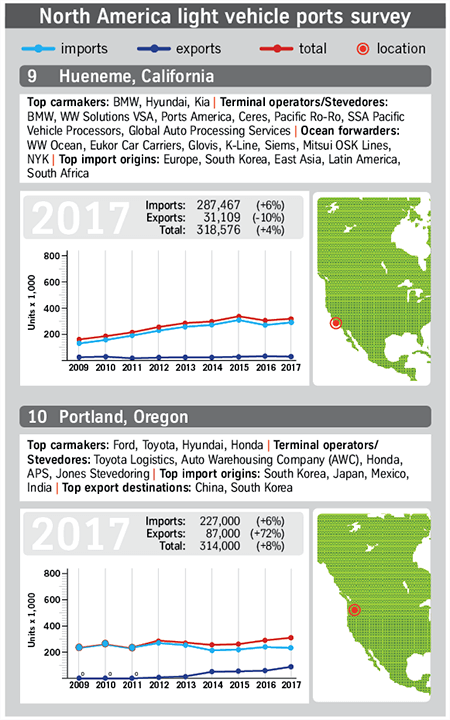 “Automotive is a booming sector for SCPA, which serves the industry via import parts/components and finished vehicle exports,” says its spokesperson. “BMW continues to expand production of new and existing models at its manufacturing facility in Spartanburg and SCPA currently handles all outbound X-series models,” says the SPCA’s spokesperson. “This volume increase is seen in finished vehicles exported as rolling stock as well as SKD and CKD vehicles via container.”
“Automotive is a booming sector for SCPA, which serves the industry via import parts/components and finished vehicle exports,” says its spokesperson. “BMW continues to expand production of new and existing models at its manufacturing facility in Spartanburg and SCPA currently handles all outbound X-series models,” says the SPCA’s spokesperson. “This volume increase is seen in finished vehicles exported as rolling stock as well as SKD and CKD vehicles via container.”
Further to that, the port of Charleston is expected to gain business this year from Mercedes-Benz Vans and also from the opening of Volvo’s $500m production facility in nearby Berkley County.
Gulf coast: Calm after the stormWhile the Gulf ports of Freeport, Galveston and Houston felt the full impact of Hurricane Harvey in August last year, all have all seen import volumes rise in 2017. Houston and Galveston were forced to suspend operations when the storm landed on August 25, but precautionary measures prevented excessive damage to infrastructure or finished vehicles. Where possible, vessels were rerouted to other ports and cargo was picked up by customers, or moved to higher ground within the terminals.
Houston saw a 12% decline in volumes but trade remains steady at the vehicle terminals operated by Auto Warehousing Company (AWC) and Volkswagen respectively.
At Galveston, new vehicle imports were one of the growth areas for the port. BMW’s VPC on the port’s Pier 10 ro-ro terminal handled 17,200 BMW and Mini vehicles in 2017, with imports coming from Europe, South Africa and Brazil.
The vehicle terminal at the Texan port of Freeport is also managed by HTS and Folkesson says it is in a good strategic location to distribute vehicles in the south of the US and Midwest. The company has space to grow that is “more or less unlimited”, he says. Despite that, a lot of carmakers are continuing to ship cars on long hauls from the east and west coasts, though HTS has gained a new (as yet unnamed) OEM that will start delivering cars in the next few months. Additionally, in April, a new shipping line started using Freeport. The company expects to handle 100,000 units in total this year.
However, Folkesson says it takes time to achieve growth, partly because the vehicle-makers’ outbound networks have become complex and binding rail agreements make it hard for them to change that. At the same time, the carmakers lack clarity in their set-up of those networks, says Folkesson.
“Take, for example, locations where they move volumes between different modes of transportation: some go through the seaports and others not. When there is a bottleneck they switch them on short notice to the ports and ocean, and capacity is needed at both outbound and inbound locations. Then a few months later, they switch them back.”
He says it is all down to managing cost and making investments in longer-term sustainable operations, even though they come at a slightly higher cost initially.
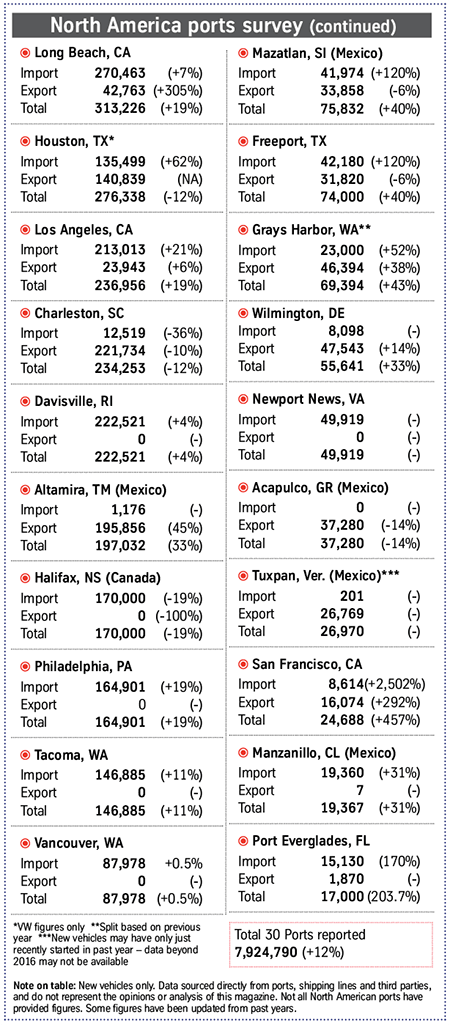 “Development of port and terminal capacity and other infrastructure requires a longer-term perspective,” he adds.
“Development of port and terminal capacity and other infrastructure requires a longer-term perspective,” he adds.
Longer-term investment is being made in the short-line rail link at Freeport and construction of phase one will be complete by November this year.
“It means that in 2019, high volume auto racks can be operated in and out of the port. Thus, we can handle efficient distribution further up north through the country.”
Land ahoy on US west coastThe US west coast shares many of the capacity constraints that other US ports do, but here innovation has been matched with investment to make more space and to use it more efficiently. There has also been a decidedly green feel to investment at the port of Long Beach.
Long Beach saw an increase in finished vehicle handling of 20% in 2017. Toyota and Lexus cars are processed at Toyota Logistics Services’ terminal at Pier B, while Mercedes-Benz volumes are imported at Pier F and then processed off-dock.
As announced last year, the port is working on a $3.1 billion replacement for the Gerald Desmond Bridge which will carry 15% of US waterborne cargo by truck from the port. Mario Cordero, the Port of Long Beach’s executive director, says the port is expected to open the span to traffic sometime after the middle of next year.
The Harbor Commission has also approved the Pier B On-Dock Rail Facility and will soon consider a baseline budget for the $820m project.
“The project will help the port achieve a goal of moving 35% of cargo via on-dock rail while improving local traffic and mitigating pollution,” says Cordero.
Congestion and available space are an issue for Long Beach. “Southern California is well known for its love affair with cars and the region’s large population – about 24m – means there is a strong demand for vehicles,” says Cordero. “Having healthy demand is positive for importers. But it is also a negative because there’s not enough land to handle OEM demand for terminal space.”
Despite their addiction to cars, Californians are also considered to have an environmental conscience, something reflected in a project Toyota is working on with Shell Oil Products US: the first hydrogen truck refuelling station at its terminal at Long Beach. The carmaker will soon unveil more about its plans to expand at the port, including the construction of a plant to produce hydrogen, water and electricity to power sustainable operations and supply fuel cell vehicles at Long Beach.
Surge in demandWhile Long Beach is looking for clean space, the port of Los Angeles says it has more than enough land to handle its 20% increase in finished vehicle traffic. Some of that increase has come from Nissan thanks to demand for the Rogue model. Manufacturing capacity of the Rogue in the US could not meet demand last year, so the company needed to import additional units from Korea and Japan, and the port of LA was able to provide additional storage.
“In the past, we have helped our terminal operator, WWL [now WW Solutions], with additional storage space to handle surges of imports,” says the port’s spokesperson. “We will work in the future with our terminal operator to accommodate any requests for additional space.”
The company has also finished a new rail yard for local rail provider, Pacific Harbor Line, which is adjacent to the WW Solutions facility and has given the logistics provider a more efficient handling and storage space for rail cars.
The port of San Diego to the south also has more room to breathe thanks to what it describes as “a major step forward” in the form of a land use designation plan for its vehicle terminal.
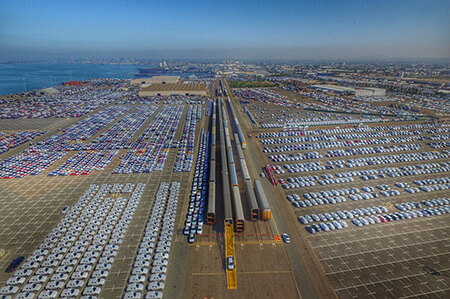 San Diego’s National City Balance Plan should provide more contiguous space to improve terminal efficiency at the port while also improving rail connections
San Diego’s National City Balance Plan should provide more contiguous space to improve terminal efficiency at the port while also improving rail connections“This National City Balance Plan is a way to help the port increase its maritime commerce and increase maritime jobs,” says Joel Valenzuela, director of maritime at the Port of San Diego. “This new land use plan will include a road closure that will provide the terminal with more contiguous space to improve terminal efficiency,” he says. “It also includes rail improvements on the terminal [with more] acreage available at a former tank farm immediately adjacent to the facility.”
The port is working with Pasha Automotive Services on the development, which Pasha’s Brian Mason says is being used as an inbound/outbound haulaway space.
The overall rehabilitation project was finished in the second quarter of this year.
“Our rail partners at BNSF also completed a complete rehabilitation of the adjacent National City Rail Yard, installing eight new tracks in place of the six ageing tracks, creating storage space for up to 50 empty rail cars adjacent to National City Marine Terminal,” says Mason.
Valenzuela adds that the connector rail track will connect the BNSF yard directly to the existing rail loop and loading tracks and allow Pasha to have both rail and rail car storage capacity, which will improve efficiencies and give Pasha easier access to empty rail cars.
The National City Rail Yard rehabilitation was completed in the first quarter of the year and combined investment in the two projects was approximately $10m in 2017/2018.
More space for SubaruThe port of Vancouver USA, in Washington state, saw a marginal increase in volumes in 2017 compared with the previous year and it exclusively handles Subaru vehicles imported from Japan. Subaru has a direct terminal lease with the Port of Vancouver USA.
Subaru of America reported record-breaking sales of almost 648,000 vehicles for 2017 and the port has enough space to deal with continued growth, according to its sales director, Steve Mickelson.
“Subaru’s facility at the port of Vancouver was developed with future growth expectations in mind,” says Mickelson. “Future capacity at Terminal 5 and Columbia Gateway will allow for continued growth in all ro-ro categories.”
Steve Mickelson, Subaru of America
The port is also investing in improved rail access from the main lines operated by BNSF and Union Pacific, called the West Vancouver Freight Access project (WVFA). The extra rail capacity will allow the port to begin planning for additional terminal space and future finished vehicle facility development, according to Mickelson.
“The WVFA, a decade-long initiative costing $250m, will more than triple the port’s rail capacity, reducing delays in rail traffic by as much as 40%, giving tenants and customers substantial room to grow. This project is expected to be completed this summer,” he says.
During the course of our research for this survey, Automotive Logistics spoke with a number of vehicle OEMs and others to get their perspective on the capacity crunch in the vital North American ports sector.
We also spoke in more detail with Brian Mason, vice-president of business development and administration at Pasha Automotive Services, about some of the challenges facing the processor and where it has seen positive gains; and with Luke Doremus, director of sales at stevedore and terminal operator Ports America, about his company’s efforts to raise efficiency and improve berth productivity.
For more information, please see:
Grappling with the capacity crunch
The Northwest Seaport Allliance, which owns the port of Tacoma just north of Vancouver USA, has added an additional 15 acres as first point of rest for vehicles being imported from Japan and Korea, including Mazda, Mitsubishi and Kia. It has also approved a 30-year lease agreement with WW Solutions for it to develop an on-terminal VPC that will have the capacity to process up to 100,000 vehicles per year, most of which will be bound for the local market or transported by rail to the US Midwest.
Benefits of open tradeThe nearby port of Portland saw an 8% rise in traffic last year and of the 314,000 vehicles, 87,000 were Ford exports. The port also handles Toyota, Hyundai and Honda volumes.
Portland has seen exports grow over the past couple of years, with China and Korea driving market demand. India is also now sending the Ford EcoSport to the US via Portland. Further imports come from Mexico, South Korea and Japan.
“Last year, the port and its terminal tenant AWC added space for auto staging in the Rivergate Industrial District near Terminal 6,” notes the port’s spokesperson. “The 18.9-acre [7.6-hectare] storage and staging yard has helped support the continued growth of export vehicles.”
That development was part of the ConnectOregon grant of $2.6m that was awarded to the port and AWC to fund part of a $7m expansion of vehicle-handling facilities in the Rivergate Industrial District. AWC put $3.5m into the project.
Finding capacity in CanadaNorth of the US border, at the Canadian port of Vancouver, volumes were also up thanks to positive vehicle sales and an increase in shipments from Mexico, alongside the main trade from Asia.
 Greater shipments from Mexico have contributed to a volume increase at the port of Vancouver, which is looking to IT solutions to improve vehicle flows
Greater shipments from Mexico have contributed to a volume increase at the port of Vancouver, which is looking to IT solutions to improve vehicle flowsVancouver mainly deals with imports and is looking to increase capacity to meet demand because of this as yard storage is constrained. It is also looking for IT solutions to improve vehicle flows through the Vancouver gateway.
Off the coast of Vancouver, meanwhile, SSA Marine Auto has been working with Nanaimo Port Authority (NPA) and transport facility builder TransDevelopment Group on a multipurpose terminal on Vancouver Island. The Nanaimo Auto Terminal will initially focus on vehicle imports and processing at NPA’s Nanaimo Assembly Wharf and already has a berth for ro-ro vessels in place. TransDevelopment is working with SSA Marine Auto on converting an existing 5,500 sq.m warehouse into a VPC.
Bill Kerrigan at SSA Marine Auto says his company will be processing and storing vehicles brought in by deep-sea with affiliate company Western Stevedoring. The company will also be managing the crossing of vehicles to the mainland with ferry companies Seaspan and BC Ferries, as well as onward delivery to dealerships.
Vancouver is a hub for western Canada but OEMs are reported to be experiencing capacity constraints with the existing east-west land bridge stretching from Halifax to Vancouver. Along with NPA and Western Stevedoring, SSA Marine says the aim was to develop the first all-water global logistics service for European automobiles to a British Columbia port.
Topics
- american honda
- Amports
- Audi
- Auto Warehousing Company
- BC Ferries
- Bentley
- BNSF
- Canada
- Data
- FAPS
- FCA
- features
- Ferromex
- Finished Vehicle Logistics
- Florida East Coast Railway
- Ford
- Ford
- Höegh Autoliner
- Honda
- Honda
- Horizon Terminal Services
- Hyundai
- Hyundai Glovis
- Hyundai Glovis
- Hyundai Kia
- Hyundai-Kia
- Inventory management
- KCS de México
- Kia
- Kia
- Lexus
- Mazda
- Mazda
- Mercedes-Benz
- Mercedes-Benz Vans
- Mexico
- Mitsubishi
- Mitsubishi
- Nissan
- Nissan
- North America
- OEMs
- Pacific Harbor Line
- Pasha Automotive Services
- Policy and regulation
- Porsche
- Ports and processors
- PwC Autofacts
- Rail
- Road
- Seaspan
- Shell Oil Products US
- Shipping
- SSA Marine Auto
- Stellantis
- Subaru
- Subaru of America
- Toyota
- Toyota Logistics Services
- Union Pacific
- United States Of America
- Volvo Cars
- VW
- Wallenius Wilhelmsen Ocean
- Wallenius Wilhelmsen Solutions
- Western Stevedoring
- WW Ocean






























